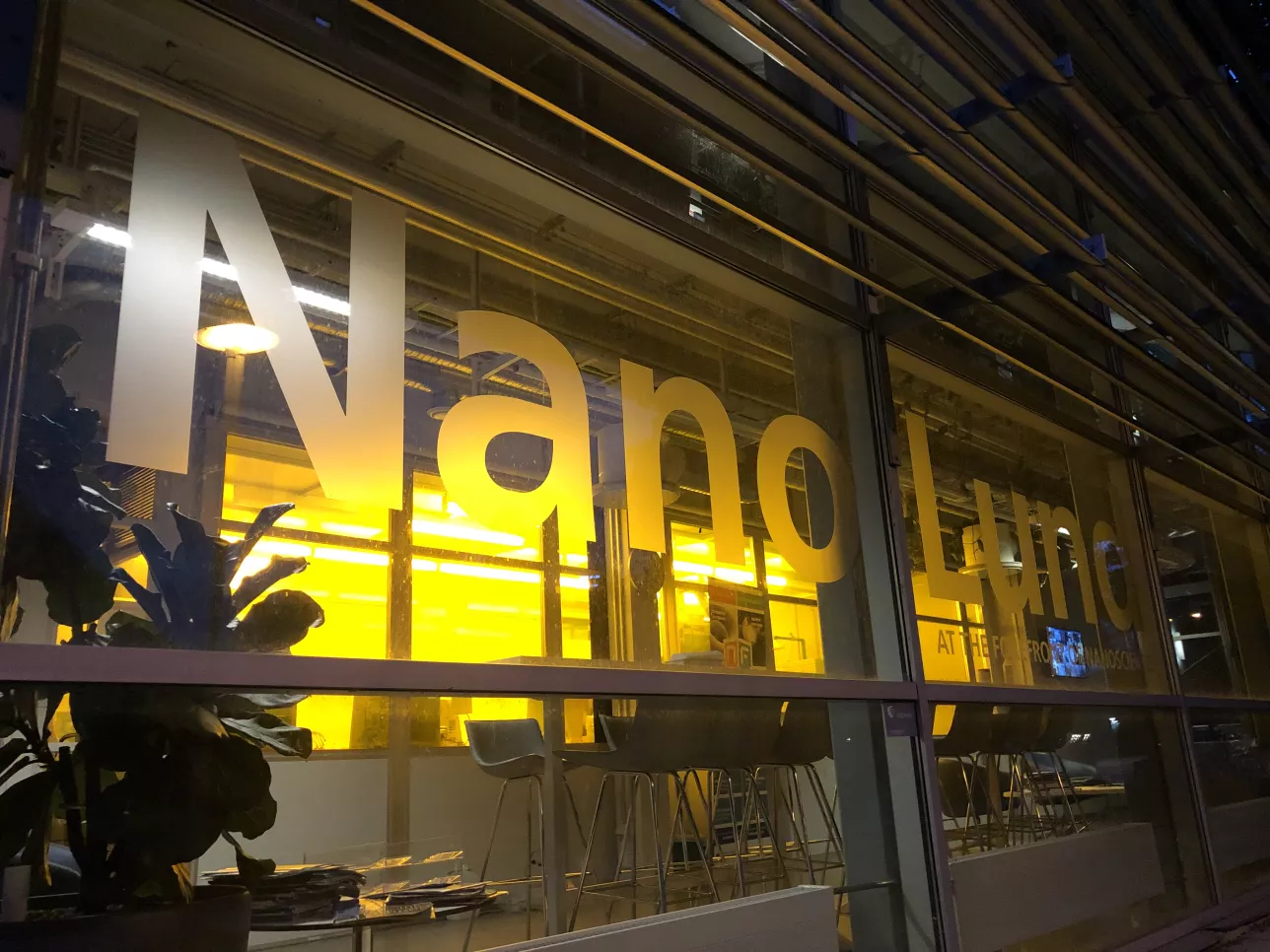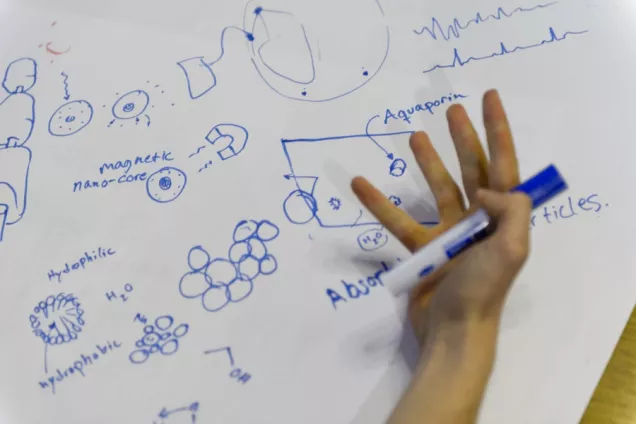Career Opportunities
Kick-start your career in interdisciplinary nanoscience and nanotechnology
A key success factor for NanoLund is our wide sharing of equipment that allows everyone – from doctoral students to new faculty – to access an incredibly wide range of capabilities within characterization, fabrication, and modelling, from the day they start working with us. NanoLund always welcomes applications from outstanding candidates for master’s projects, doctoral studies, or postdoctoral work. Welcome with your application!
We offer:
- a creative, world-class interdisciplinary research environment for fundamental and applied nanoscience
- state-of-the-art infrastructure for the fabrication and characterization of nanostructures
- a strong international nanoscience network
- a highly regarded scientific education
- internships in nanotechnology industry
- intellectual property training
- family-friendly living conditions and a high degree of social security
- a competitive salary and full employment contracts for doctoral students and postdocs
Current vacancies in NanoLund research groups
All positions are regularly posted in the Lund University recruitment system.
Selected vacancy announcements within NanoLund are listed below. To apply for a position, click the Login and Apply button in the vacancy announcement, and you will be guided to the recruitment system.
Postdoctoral position in Deep learning based design of protein-semiconductor metamaterials
The postdoctoral project aims to design de novo proteins that self-assemble into defined architectures and guide the formation of semiconductor materials with sub-nanometer precision. The position is part of a highly interdisciplinary collaboration between the Departments of Chemistry and Physics, combining expertise in protein design, biochemistry, and semiconductor physics. The research will be conducted at the Division of Applied Biochemistry, in close collaboration with groups at the Center for Molecular Protein Science (CMPS) and semiconductor characterization teams within NanoLund.
Recent breakthroughs in deep learning–powered protein design, recognized by the 2024 Nobel Prize in Chemistry, have enabled the creation of proteins with near-atomic accuracy. Models such as RFdiffusion, LigandMPNN, and hallucination-based frameworks can now generate symmetric oligomers, cages, and backbones while optimizing sequence properties. An emerging frontier focuses on designing proteins that act as templates for inorganic interfaces, forming symmetric oligomers that control inorganic material polymorph, facet composition, and geometry. This project aims to establish the first design framework for programmable, functional protein–semiconductor metamaterials, contributing to a broader vision of sustainable biofabrication of (opto-)electronic nanotechnology.
The main duties involved in a post-doctoral position is to conduct research. Teaching may also be included, but up to no more than 20% of working hours. The purpose of the position is to develop the independence as a researcher and to create the opportunity of further development.
Specific work duties will include developing computational protein design pipelines to enable the design of: (1) volumes – symmetric or Janus assemblies that encapsulate defined voids; (2) interfaces – templates and catalytic motifs that direct the controlled formation of target semiconductor materials within confined spaces; (3) pores – structures that regulate the selective entry of metal species into nanocompartments; and (4) inert surfaces – outer assemblies that remain stable in supersaturated solutions.
Group leader: Amijai Saragovi
Read complete vacancy and apply online before 22 December 2025
Doctoral student in Physics within THz-electron spin resonance-ellipsometry
The PhD position is placed at the Division of Solid State Physics at the Department of Physics. A significant part of the research at the division is in characterization of semiconductor materials. The department hosts the research group of Prof Vanya Darakchieva. Together with its co-operating partners, the group has developed in recent years THz ellipsometry and its applications in characterization of semiconductor materials and devices. These lay the foundation for the next generation of high-frequency and high-power electronics being developed together with leading Swedish industrial partners.
The PhD advisor is Prof Vanya Darakchieva. She has extensive experience in the development of new semiconductor materials for high frequency and power electronics. The research also focuses on developing spectroscopic techniques to study electronic and transport properties of materials from bulk to nanoscale.
A specific direction to be further developed is to investigate electron spin resonances with the THz ellipsometer, so-called high field EPR. It involves the development of equipment and strategies based on polarisation optical methods and aims at defect characterisation in semiconductors. The development is mainly basic research but has strong links to future quantum technology concepts.
You will primarily devote yourself to your doctoral programme, which includes participation in research projects as well as third cycle courses, seminars and conferences.
The aim of the PhD project is to conduct research in THz material analysis to expand the scope of THz ellipsometry and optical Hall effect to electron spin resonance ellipsometry. The method will mainly be applied in materials science, in particular for the investigation of crystal phases and defects in semiconductors. In addition to nitride material systems, a focus area will be Ga2O3 and other ultrawide bandgap semiconductors. The duties also include participation in teaching and other departmental work (however, a maximum of 20% of working hours).
To be eligible for admission and employment as a doctoral student, you must fulfil the requirements described in the complete vacncy text.
Group leader: Vanya Darakchieva
Read complete vacancy and apply online before 15 January 2026
Doctoral student in Physics with a focus on the development of novel X-ray imaging methods with AI+Physics
The Division of Synchrotron Radiation Researchis a part of the Department of Physics and has more than 50 employees. The focus of the research is on experimental studies of electronic, structural, and chemical properties of materials. At the Division we use and develop a wide range of large facility- and lab-based techniques. We are additionally engaged in the development of the MAX IV Laboratory in the fields of beamlines, experimental stations, techniques for Synchrotron radiation and the accelerator systems. MAX IV is the first operational diffraction-limited storage ring in the world, offering new opportunities to develop novel X-ray imaging techniques that were not possible before.
This project aims to develop and demonstrate a novel X-ray imaging technique based on scattering to explore a new spatiotemporal frontier for hierarchical characterization. This technique will be commissioned at the ForMAX beamline at MAX IV by studying hierarchical self-assembly processes that have the potential to lead to the next generation of optimal bioinspired materials.
In particular, the candidate will work on: i) commissioning and establishing this novel technique, granting the opportunity to pioneer novel research opportunities enabled by one of the brightest sources in the world, ii) developing AI+Physics end-to-end reconstruction algorithms that will enable a new regime of spatiotemporal hierarchical characterization. The project is mainly computational with an experimental component.
The main duties of doctoral students are to devote themselves to their research studies which includes participating in research projects and third cycle courses. The work duties can also include teaching and other departmental duties (no more than 20%).
A person meets the general admission requirements for third-cycle courses and study programmes if he or she:
- has been awarded a second-cycle qualification, or
- has satisfied the requirements for courses comprising at least 240 credits of which at least 60 credits were awarded in the second cycle, or
- has acquired substantially equivalent knowledge in some other way in Sweden or abroad.
A person meets the specific admission requirements for third-cycle studies in Physics if he or she has:
- passed an independent project (e.g.degree project) of at least 30 credits in a relevant subject
Equivalent knowledge acquired through corresponding programmes will be assessed individually. Finally, the student must be judged to have the potential to complete the programme.
Supervisor: Pablo Villanueva-Perez
Read complete vacancy and apply online before 15 January 2026
Doctoral student in synthesis and characterization of novel perovskite quantum materials for light-converting applications
This position will be part of the Light-Activated Energy Materials (LAEM) Group led by Assistant Professor Maning Liu within the Centre for Analysis and Synthesis (CAS) at the Department of Chemistry. We are a highly international unit and strive to maintain gender balance. Research at CAS (with more than 120 employees from >20 countries) focuses on inorganic, organic, polymer and advanced materials synthesis, as well as advanced analysis and characterization techniques, with applications across such topics as solar cells, solar fuels, energy storage and light-related matters.
As a doctoral student, you are both admitted as a student and employed at Lund University. As a doctoral student, you will be trained in a scientific approach. Doctoral studies end with a thesis and a doctoral degree.
The focus of the research will be on the design, synthesis and characterization of novel 2D lead-free perovskite quantum materials, e.g., multi-quantum wells, for their light-converting applications such as solar cells (including indoor photovoltaics) or light-emitting diodes (LEDs). Metal halide perovskites have been recognized as the most promising candidate for a wide range of potential uses in solar energy applications such as solar cells and photocatalysis. To be able to meet the rising challenges in eco-friendly and sustainable production of materials for these applications, novel lead-free halide perovskites, particularly in the quantum-size form, must be explored. For this reason, we are aiming to develop synthesis and deepen understanding of 2D lead-free perovskite quantum materials with potential for the fabrication of efficient and stable optoelectronics.
You will primarily devote yourself to your doctoral programme, which includes participation in research projects as well as third cycle courses, seminars and conferences. The duties also include participation in teaching and other departmental work (however, a maximum of 20% of working hours).
To be eligible for admission and employment as a doctoral student, you must fulfil the requirements listed in the complete vacancy in the link below.
Group leader: Maning Liu
Read complete vacancy and apply online before 12 January 2026
Research engineer at Lund Nano Lab
The Department of Physics at Lund University runs the world-class semiconductor nanofabrication facility Lund Nano Lab (LNL). LNL is part of Myfab – the national infrastructure for micro and nano fabrication and a key infrastructure for Nanolund. The lab hosts approximately 80 tools, including those for deposition, growth, etch and patterning of semiconductor materials. There are also a number of specialised instruments for characterisationand metrology. The LNL team includes 11 highly qualified scientists, engineers and technicians.
Lund Nano Lab is seeking an experienced Equipment Engineer with a focus on Metalorganic Vapor Phase Epitaxy (MOVPE) and related semiconductor processing equipment. In this role, you will be responsible for the maintenance, service coordination, safety, and user training of advanced material processing tools, ensuring reliable operation and continuous improvement. You will work closely with students, scientists, engineers, and equipment suppliers to support both daily research activities and long-term development goals. With the upcoming expansion to a new cleanroom at Science Village Lund, this is an exciting opportunity to contribute to a growing and dynamic research environment.
In this position, you will get the opportunity to work in a world class research environment with highly qualified colleagues. As a member of our team we will offer you on the job training and development in your professional role as engineer at LNL.
In this position, you will be responsible for:
- Equipment Management: Install, maintain, and troubleshoot complex processing and characterisation equipment and systems. The primary focus will be on Metalorganic Vapour Phase Epitaxy (MOVPE) systems and their supporting infrastructure (media, gasses, abatement).
- Preventive Maintenance: Conduct routine maintenance and calibrations on tools per manufacturer specifications to ensure the safe, reliable, and efficient operation of various semiconductor processing tools. Manage and maintain the inventory of critical spare parts.
- Uptime Improvements: Collaborate with team members to develop and enhance preventive maintenance strategies aimed at improving uptime.
- Diagnostic and Repair: Use diagnostic tools for equipment checks, calibrations, and performance assessments. Work with equipment manufacturers and vendors for technical support and solutions to repair electrical and mechanical issues.
- New Equipment Integration: Assist in the procurement, installation, and commissioning of new equipment, including start-up and acceptance testing.
- User Support: Provide training, qualification, and support to users of the infrastructure.
Qualifications required for the position include:
- Educational Background: Degree in a relevant field, such as mechanical or electrical engineering, or equivalent education.
- Technical Maintenance Experience: Several years of hands-on experience in maintaining semiconductor processing equipment.
- Gas and Vacuum Systems Expertise: Practical experience in the installation and maintenance of gas distribution, gas detection and vacuum systems.
- Troubleshooting Skills: Proven ability to diagnose and repair gas distribution and cooling systems down to the component level.
- Vacuum Principles Knowledge: Understanding of basic vacuum principles and familiarity with vacuum components, including pumps, gauges, and valves.
- English Proficiency: Strong command of English, including the ability to draft technical documentation.
- Strong Communication Skills: Excellent ability to communicate effectively with team members and stakeholders.
We will place great emphasis on personal suitability within the team. You are an initiative-taker, independent and service-minded and have good cooperative ability. Consideration will also be given to how the applicant’s experience and skills complement and strengthen the technical work within the group.
Group leader: Luke Hankin
Read complete vacancy and apply online before 4 January 2026
Research Engineer to The Department of Electrical and Information Technology
The Department of Electrical and Information Technology, EIT, at The Faculty of Engineering, LTH, Lund University is one of the larger departments with around 120 employees. The department consists of four divisions and a group of technical and administrative staff. The Division of Electromagnetics and Nanoelectronics, EMN, within the department conducts research in the field of semiconductor materials, components and circuits as well as electromagnetism. The research has many contacts with international partners as well as industry.
We are now looking for a new colleague in the form of a Research Engineer with focus on semiconductor technology.
You will mainly work with running the device part of the Lund University node within the EU ChipsAct Wide Bandgap Pilot line (WBG). This is focused on development of GaN-, AlGaN- and AlN semiconductor devices, for power and RF applications.
You will be working with setting up and managing chip fabrication and device modeling using TCAD and electrical measurement of components.
There are also possibilities in directly interacting with other research projects within wide bandgap devices, as well as interacting with doctoral students and supervision of master students within the department.
Part of the experimental work will be carried out in the cleanroom at Lund Nano Lab.
Required qualifications:
- A Ph.D. within Physics, Electrical Engineering, Nanoscience or equivalent.
- Documented experience of semiconductor processing in cleanroom, especially of GaN-based transistors.
- Documented experience in electrical characterization of semiconductor components in DC and RF.
- Very good oral and written profiency in English.
Additional requirements:
- Experience in TCAD modeling of semiconductor components for electrical applications.
- Experience in analyzing component measurement data.
- Experience of working in larger research projects.
- Experience of teaching or other pedagogic activities.
Great importance will be placed on personal qualities. You are an initiator, independent and service-oriented and have good collaboration skills. Consideration will also be given to how the applicant's experience and skills complement and strengthen the technical work within the division and department.
Group leader: Erik Lind
Read complete vacancy and apply online before 30 December 2025
Would you like to have your vacancy posted here? Please send an e-mail to webmaster [at] nano [dot] lu [dot] se (webmaster[at]nano[dot]lu[dot]se).


HR Excellence in Research
Lund University has received EU’s certification, HR Excellence in Research, for its dedication to support career development of researchers.
Doctoral studies

Research opportunities in Sweden
The Swedish research council VR has collected some useful information and links about moving to Sweden to do research
Connect with us on LinkedIn
WISE: Wallenberg Initiative Material Science for Sustainability
The Wallenberg Initiative Materials Science for Sustainability (WISE) is the largest-ever investment in materials science in Sweden and will encompass major efforts at six of Sweden’s leading universities over the course of (at least) 10 years.

Master thesis projects available
Need help finding the right NanoLund supervisor for your project? Browse the topics currently available.


